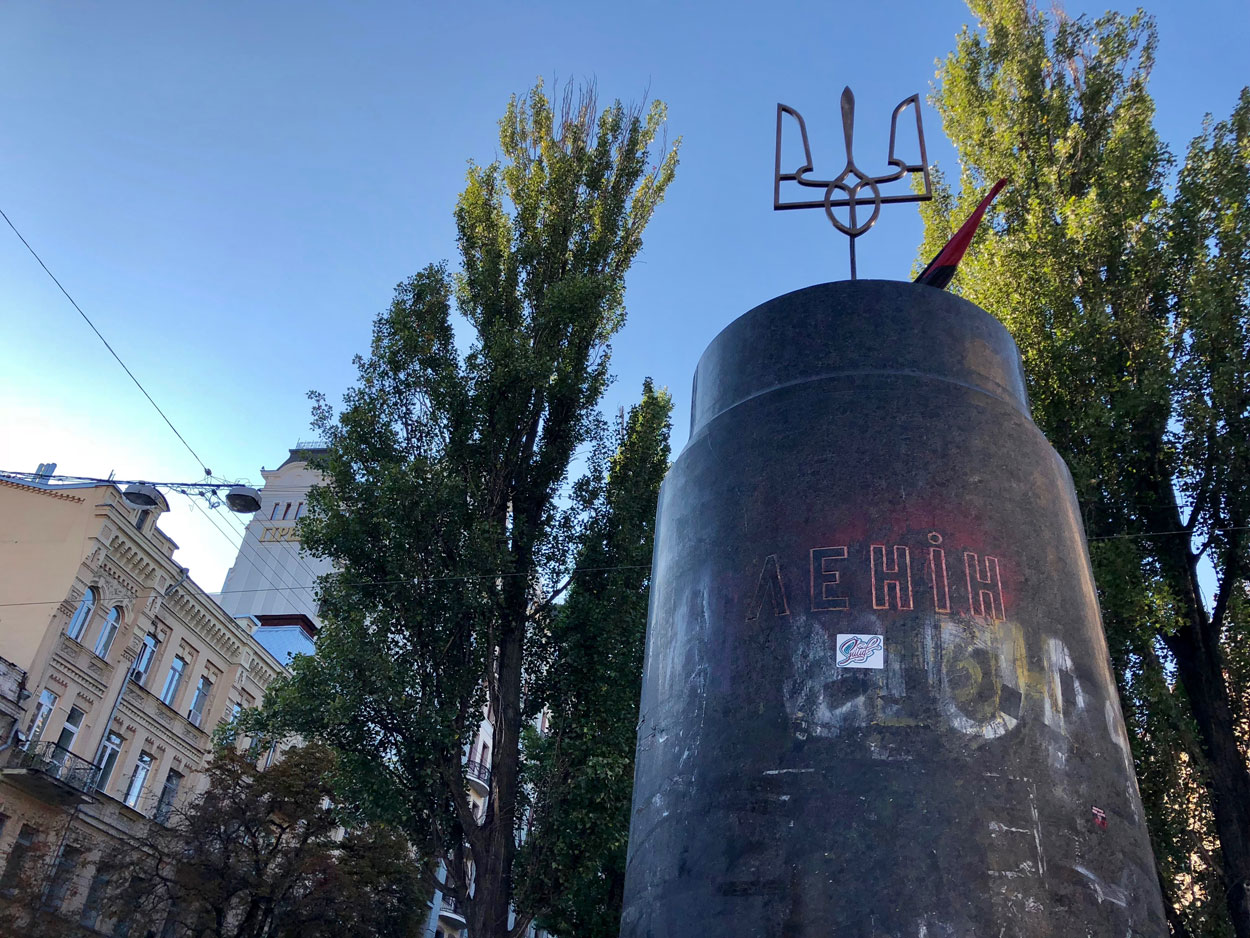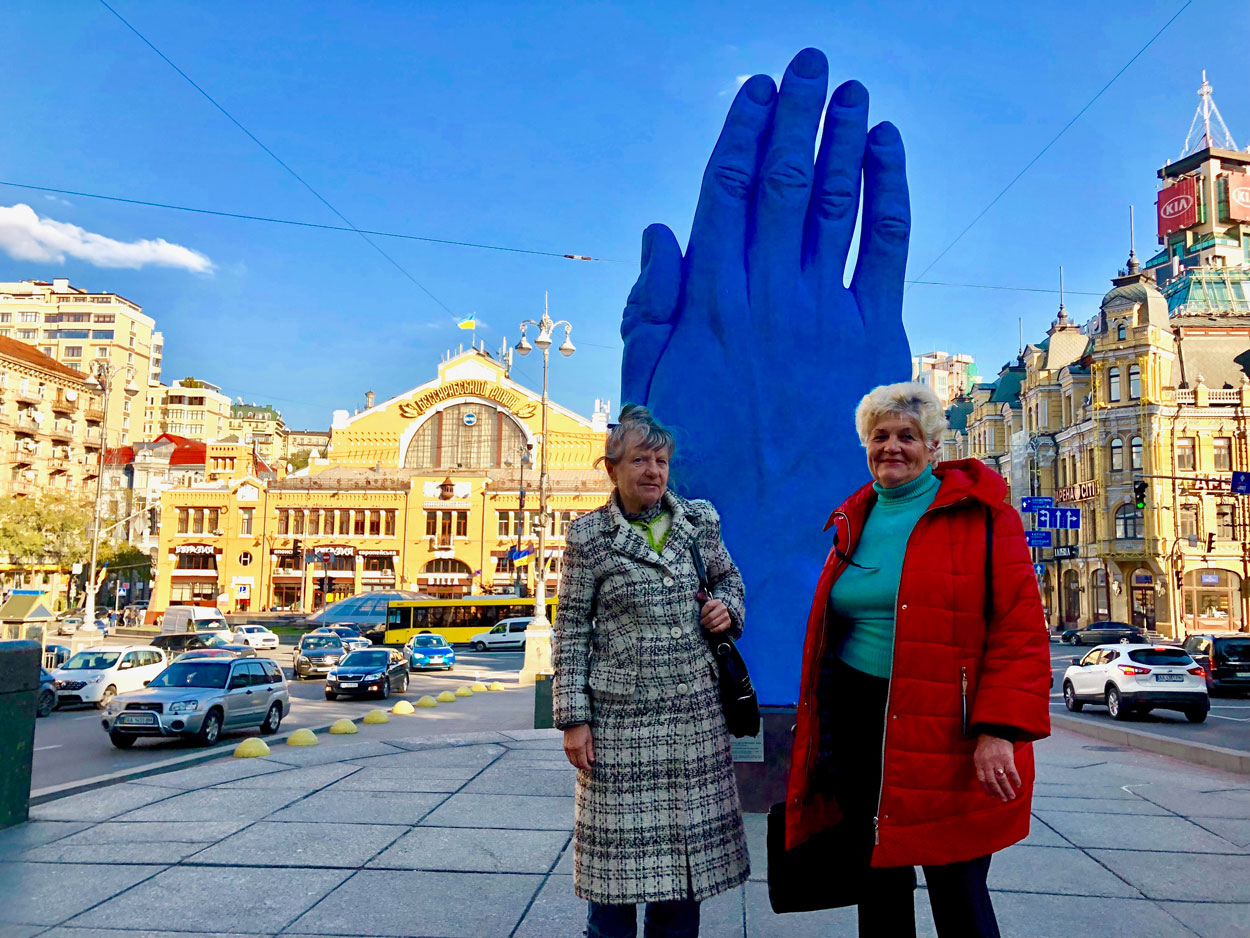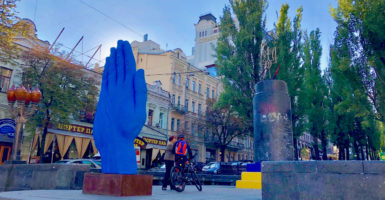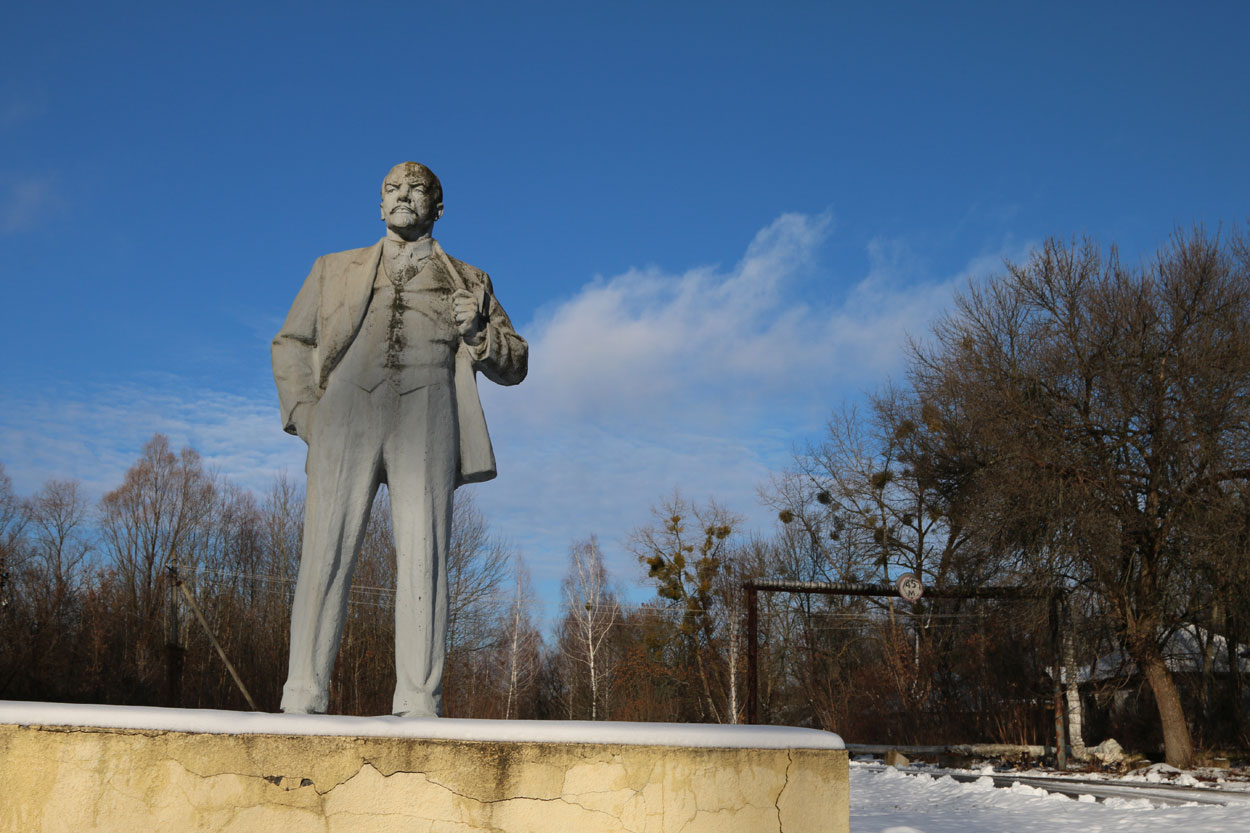KYIV, Ukraine—A statue of Vladimir Lenin stood over Kyiv’s Bessarabska Square from 1946 until pro-democracy protesters tore it down on Dec. 8, 2013—more than 22 years after Ukraine’s independence from the Soviet Union.
Today, a metal trident now tops the denuded black granite pedestal. The trident is Ukraine’s national emblem. It’s a powerfully symbolic juxtaposition: The symbol of a free and independent Ukraine atop a vestige of the country’s Soviet past.
There is also now a new, separate monument a few meters in front of the pedestal where Lenin once stood.
Named “Middle Way,” the statue is of a giant blue hand. It’s the work of Romanian artist Bogdan Ratna and part of Kyiv’s “Moving Monuments” project in which temporary pieces of artwork are displayed around the city.

Today, a Ukrainian trident tops the pedestal where a statue of Vladimir Lenin once stood. (Photos: Nolan Peterson/The Daily Signal)
Kyiv city officials say the blue hand statue is meant to symbolize “friendship and cooperation,” as well as Kyiv’s burgeoning identity as an international, cosmopolitan city welcoming to foreigners of all stripes.
So far, Kyiv’s residents have received the “Middle Way” monument with lackluster enthusiasm. A common joke on social media is that the blue hand symbolizes the lack of hot water in certain parts of the city. Some have also joked that the statue is a reference to the movie “Avatar.” There have been some sexual jokes, too, which aren’t fit for print.
Yet, despite the online jesting, the new statue has become a popular place for photos.
On this brisk autumn day, groups of young people stand in line to take photos before the giant blue hand. A man and a woman, presumably a couple, take photos of each other while alternately giving a thumbs up and a peace sign.
Once the couple clears out, two young women step forward and set to work, taking a flurry of pictures. One of the women simply stands and smiles for the camera. Her counterpart, however, gives a peace sign amid a litany of other poses.
Meanwhile, two older women lumber up the stairs from behind the blue hand monument, emerging from the vast underground mall known as Metrograd, which spans for blocks under Bessarabska Square.
The two aged women curiously regard the line of people waiting to snap photos with the giant blue hand. Before the monument, they both look up curiously, craning their necks. One of the ladies puts down her shopping bag and stoops to read the inscription at the monument’s base.
This correspondent asks these two older Ukrainian women what they think about the new monument. Their names are Galina and Anna; they agree to chat and have their photos taken but ask that their last names and ages not be published.

Galina, left, and Anna before the “Middle Way” statue. “Listen, my home, our home, is in Europe. Not with Russia,” says Galina.
Galina, who wears a plaid, gray overcoat to match her grayed hair, says she doesn’t really get the artistic intent of the statue, but she’s happy about welcoming foreigners to Ukraine.
“It sends the right message,” she says. “Listen, my home, our home, is in Europe. Not with Russia.”
Anna, whose hair is coiffed and dyed blond, looks up at the metal Ukrainian trident where Lenin once stood. The word “Lenin” is still clearly engraved in the black stone pedestal.
“Lenin is kaput,” Anna says. She draws a thumb across her neck and grins.
“Goodbye,” she adds, stretching out the words in Russian—das…vi…dan…iya.
“I used to be a Komsomol, you understand,” Anna says with an emphatic head nod, referring to the Soviet Union’s Communist youth organization, the All-Union Leninist Young Communist League.
She then shakes her head and adds, “I used to believe in the Soviet Union, but it was all lies.”
Galina, for her part, nods her head in silent affirmation.
Anna looks up again at the Ukrainian trident. “My God, I’ve seen a lot of changes,” she says. “But it’s all for the better.”
Empty Pedestals
The protesters who tore down Lenin’s statue on Bessarabska Square were part of a pro-European uprising known as the Euromaidan. Those street protests began in response to a November 2013 decision by Ukraine’s then-President Viktor Yanukovych to ditch a pro-European trade deal in favor of one with Russia.
That decision fatally misread the pulse of the Ukrainian nation and how passionately its youth wanted to become part of Europe and not be stuck in the purgatory of Russian vassalage. Ultimately, the ensuing months of pro-European protests snowballed into a full-blown revolution that led to Yanukovych’s February 2014 ouster.
According to Ukrainian news reports, about 700 Lenin monuments were torn down in Ukraine in the first year after the 2014 revolution. Yet, in December 2015, about 1,300 monuments to Lenin still remained standing.
Then, by January 2017, Ukrainian officials announced that all remaining statues of Lenin in government-controlled Ukrainian territory were gone.
The 2014 revolution set Ukraine on what many officials and experts now say is an irreversible political, economic, and cultural divorce from Moscow. Thus, one could make the case that Ukraine’s true independence was not achieved until 2014—decades after the Soviet Union’s demise.
Yet the battle for Ukraine’s future is not over.
Since the February 2014 revolution, Ukraine has been locked in a de facto trench war against Russian forces in eastern Ukraine’s Donbas region.
Today, the artillery still thunders and the Kalashnikovs still crackle along a 250-mile-long front line. Civilians and soldiers on both sides still die daily in what remains Europe’s only ongoing land war—a war that has killed more than 10,300 Ukrainians.
And on another, invisible front, Ukrainian reformers are still fighting a tooth-and-nail fight against corruption. In the eyes of many Ukrainians, the fight against corruption is equally as important to Ukraine’s future as the ongoing trench war in the east to hold Russia’s invasion at bay.
Suffering
The past century has not been gentle to Ukraine.
Josef Stalin organized a mass famine in the 1930s, known as the Holodomor, which killed about 4 million Ukrainians. From 1939 to 1945, about 7 million Ukrainians died in World War II (including 600,000 Ukrainian Jews killed in the Holocaust)—corresponding to roughly one out of every five Ukrainians alive in 1940.
Decades later, Ukraine’s independence from the Soviet Union in 1991 proved to be an economic and demographic catastrophe.
By 1996, five years after independence, Ukraine’s gross domestic product had fallen by about 60 percent from its 1990 level. (In comparison, the U.S. GDP fell 30 percent during the Great Depression from 1929 to 1933.)
Ukrainian industrial production reduced by more than half from 1991 to 1996—a bigger drop than what the Soviet Union experienced during World War II when half the country was occupied by Nazi Germany.
Moreover, with the Soviet Union’s breakup, many Ukrainians saw their life savings basically disappear overnight. Hyperinflation from 1992 to 1994 left about 80 percent of Ukrainians in poverty and roughly one-quarter of the population unemployed.
Consequently, the purchasing power of the average Ukrainian salary for basic food items fell by about 95 percent from 1992 to 1994, according to studies from the Kyiv National Economic University.
Reflecting a common trend among post-Soviet countries, Ukraine’s population has been steadily diminishing since the end of the Soviet Union.
By the end of 2016, Ukraine’s population had decreased by about 9.5 million from its 1993 peak of 52,244,100—a net 18 percent drop in 23 years. That loss exceeds the number of Ukrainians who died during World War II, albeit over a much longer period.
The United Nations estimates Ukraine’s population could drop to 36.4 million by 2050.
The 2014 revolution came with its attendant hardships, too, including an economic downturn and Russian invasions on two fronts.
Thus, many young Ukrainians are jaded about their country’s future and have moved abroad in search of work, or would choose to do so if given the opportunity. Consequently, Ukraine’s population decreased by 198,000 in 2017 alone, the State Statistics Service of Ukraine reported.
And there’s a war on, too.
About 60,000 Ukrainian troops remain deployed to the trench lines and embattled villages of the Donbas, weathering daily artillery and sniper pot shots from a combined force of about 35,000 pro-Russian separatists, Russian regulars, and foreign mercenaries.
The war has killed more than 10,300 Ukrainians and on average one Ukrainian soldier still dies every three days.
However, the news from Ukraine is not all doom and gloom.
The 2014 revolution has brought about some positive changes, too, such as sweeping health care reform, pension reforms, and some key anti-corruption initiatives. The country’s military has been totally revamped and officials are planning infrastructure projects across the country, including much-needed road improvements.
For his part, Ukrainian President Petro Poroshenko has scored some high-profile wins for the Ukrainian people since 2014, notably, a visa-free travel arrangement for Ukrainians in the European Union.
Ukraine’s post-revolutionary government has also made progress in other key areas, such as waning Ukraine off its dependence on Russian natural gas, a free trade agreement with the European Union, and reforms that have made Ukraine more appealing to foreign investment.
Ukrainian civil society has flourished during the past four years, spurring the emergence of civilian “watchdog” groups, which intend to hold the government to account for corruption.
This is a trend which, while in its adolescence, underscores a departure from the post-Soviet era of thug rule, even if some of these watchdog groups still face substantial government pushback, or even outright persecution in some cases.
Still, many reformers say progress has been too slow.
In a poll conducted in September and October of 2017 by the International Republican Institute, a U.S. think tank, 46 percent of Ukrainians said corruption was among the top three problems facing their country—compared with 43 percent who said Russia’s ongoing proxy war in the east was among the country’s top three problems.
Moreover, while Ukraine’s economy is slowly recovering from the body blow it took in the wake of the 2014 revolution, most Ukrainians remain financially worse off than they were prior to 2014.
The Ukrainian hryvnia’s value slid from about 8 to 1 against the U.S. dollar in 2013 to its current value of roughly 27 to 1. Consequently, inflation is up and the average Ukrainian citizen’s spending power is way down.
With an average monthly salary of around $270, about 60 percent of Ukrainians live in poverty. And although Ukraine’s gross domestic product is slowly gaining, it still hasn’t returned to its pre-revolutionary levels. In 2018, Ukraine’s GDP hit about $112 billion—roughly 60 percent of the 2013 number, $183 billion.
Without a doubt, the intervening years after the 2014 revolution have been hard on most Ukrainians. But one thing is for certain: Russia is no longer pulling the puppet strings of control over Ukraine anymore.
The country’s future is now firmly set on a one-way path that leads away from Russia with an eye toward the West.
The statues of Lenin are now all gone and will be forever, but the question remains—what will replace them?





























